15 Cat Sleeping Positions (Posture) and How They Affect Health
Table of Contents
Breaking The Myth: Do Cat Sleeping Positions (Posture) Matter?
You might wonder if your cat’s sleeping position actually means anything, or if it’s just random. It’s more than whimsy; the way your cat sleeps can give you subtle clues about their comfort, health, and emotional state.
Exploring your cat’s sleeping positions helps you understand their needs and notice any changes in behavior early. Recognizing shifts from relaxed, exposed poses to tightly curled ones, for example, can sometimes alert you to stress or discomfort.
If you’re interested in cats and their unique behaviours, do check out other article about cat tail language: All You Need to Know About Cat Tail Language
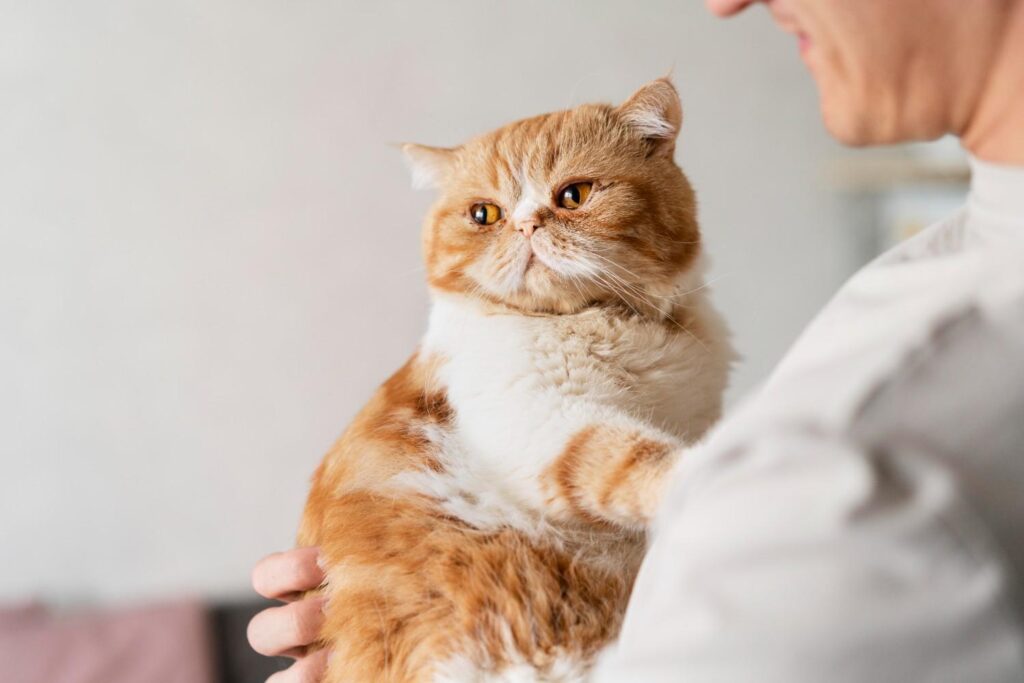
Examples Of Common Cat Sleeping Positions
There are actually a lot of cat sleeping positions and although not definite, we can definitely look to them as clues to what they are conveying or feeling.
Here, we’ve listed some of the more common cat sleeping positions and what they might indicate.
1. In the Litter Box Cat Sleeping Position
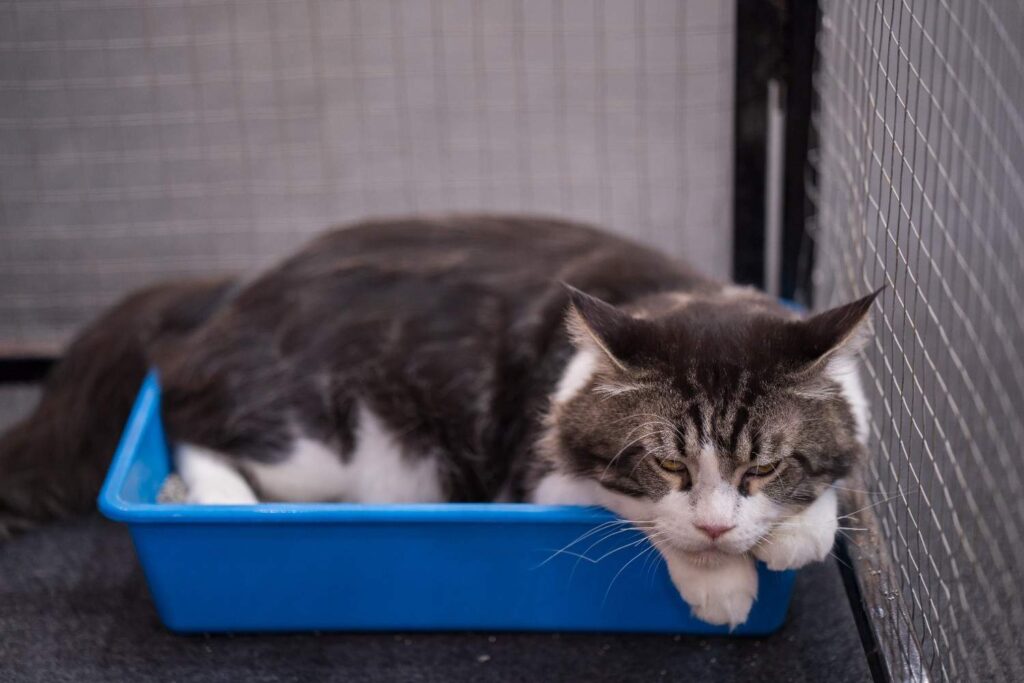
Cats may prefer in a litter box for several reasons:
- Stress
- Unwellness
- Medical concern
When you find your cat sleeping or resting in the litter box, it’s important to take notice. Cats typically do not choose this spot for relaxation. This unusual behavior can signal that your cat is feeling unwell or stressed.
A common message your cat may be communicating is discomfort. Medical concerns, such as urinary tract infections or digestive problems, can drive cats to stay close to the litter box. The litter box becomes a place of reassurance or relief because they associate it with attempts to resolve their discomfort.
In some cases, cats may seek out the litter box’s enclosed space as a private, quiet spot during illness or when feeling vulnerable. The scent and familiarity might make it feel like a secure retreat if your cat is not feeling well enough to move far.
Prompt attention is key. If you recognize this sleeping position in your cat, contact your veterinarian to rule out health concerns and ensure your cat’s well-being.
2. The Loaf Cat Sleeping Position (Posture)
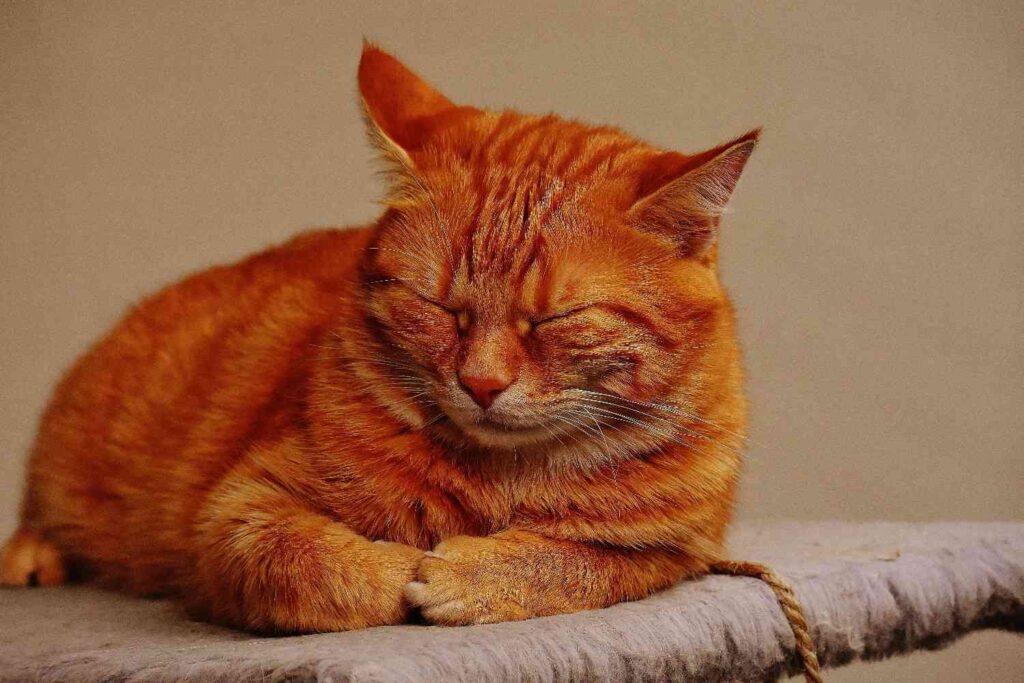
Cats may prefer the loaf position for several reasons:
- Warmth
- Security
- Low commitment rest
The loaf position is a classic cat posture—your cat sits upright with their front paws tucked neatly beneath their body, creating a shape that resembles a loaf of bread. Their tail is often wrapped close, and their head may rest above their paws or be upright.
A loafing cat is sending a subtle message of trust. Tucking the paws and tail under the body means your cat feels safe, yet doesn’t want to be caught off guard. There’s a gentle calmness about a loafing cat, but you may notice their ears flick or eyes track movement—evidence of a relaxed, yet watchful, state.
Loafing is a sign your cat feels comfortable around you, but stays just a little bit ready for action.
3. Curled Up Cat Sleeping Position (Posture)
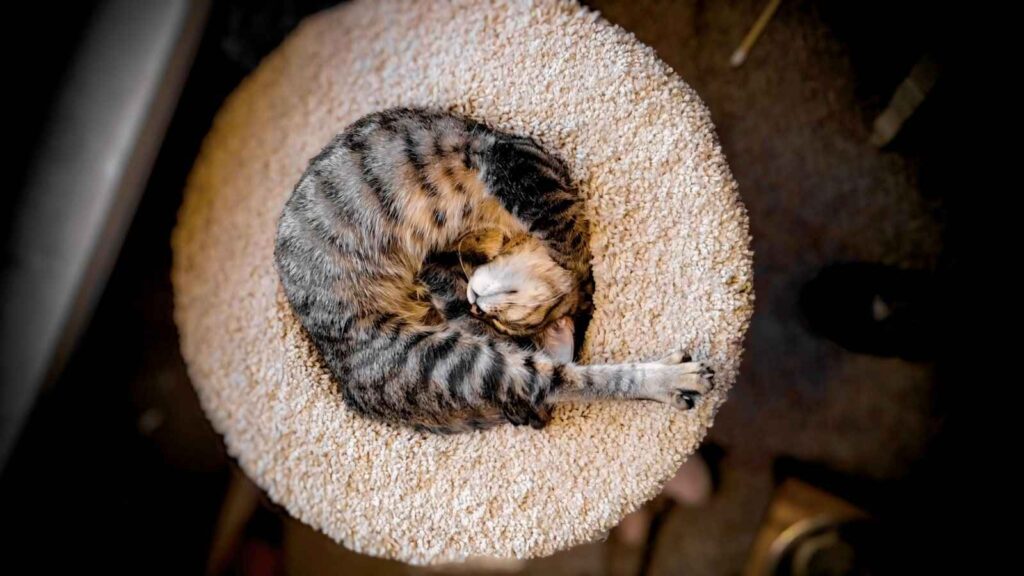
Cats may prefer the curled-up position for several reasons:
- Protection
- Warmth
- Comfort
The curled up sleeping pose, often called the crescent, is probably the most familiar position you’ll see your cat adopt. Your cat forms a compact shape by tucking its paws, wrapping its tail around its body, and pressing its nose towards the chest.
Primarily, it helps preserve body heat. Cats naturally seek warmth, and curling tightly is an effective way to conserve it. On cold days, you might notice your cat selecting this pose more frequently, especially when napping on a chair, windowsill, or even in a laundry basket.
Protection is another key reason. When cats curl up, they shield their vital organs. This behavior has roots in their wild ancestry, offering both comfort and an increased sense of safety.
4. Superman Cat Sleeping Position (Posture)
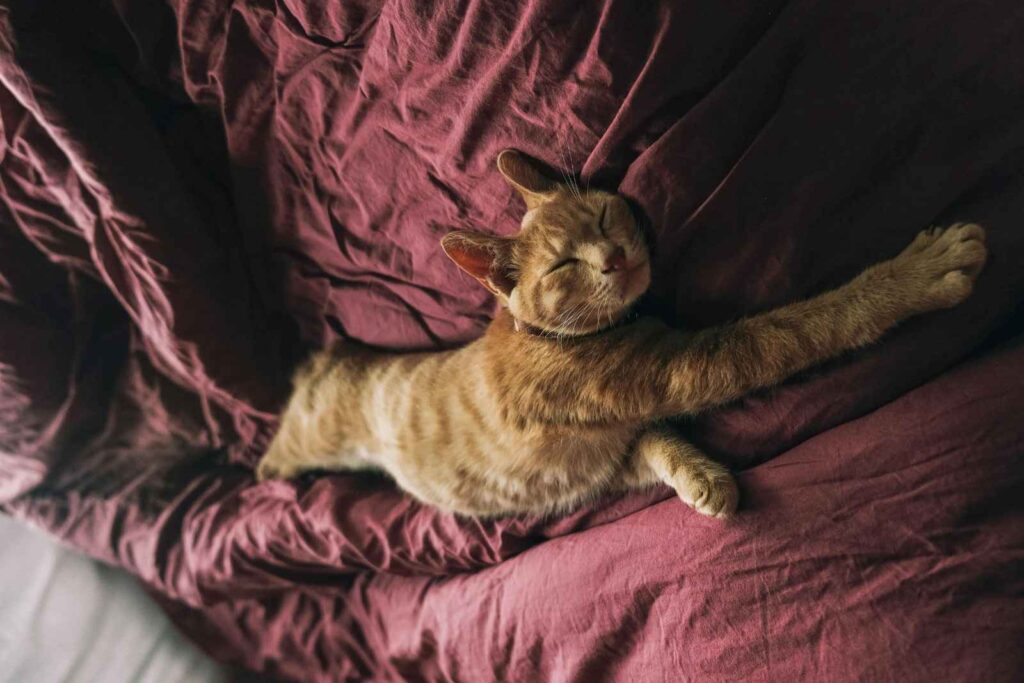
Cats may prefer the super-cat position for several reasons:
- Safety
- Awareness
- Relaxation
In the Superman sleeping position, you’ll see your cat sprawled out on their stomach with front legs reaching forward and back legs stretched straight out behind. This looks a bit like the classic superhero pose mid-flight, making it an easy one to spot.
A cat adopting this pose often feels comfortable and at ease in its surroundings. Yet, by keeping all four paws extended, they can quickly get up if needed. This readiness shows both relaxation and a touch of alertness.
If your cat’s tail is laid out naturally along their body or loosely extended, it signals calmness and trust.
Cats reserve this position for places where they feel safe but still want to stay aware of their environment because not only due to sleep, keeping a clean environment can reduce the chances of cats getting common cat skin diseases.
5. Acrobatic Cat Sleeping Position (Posture)
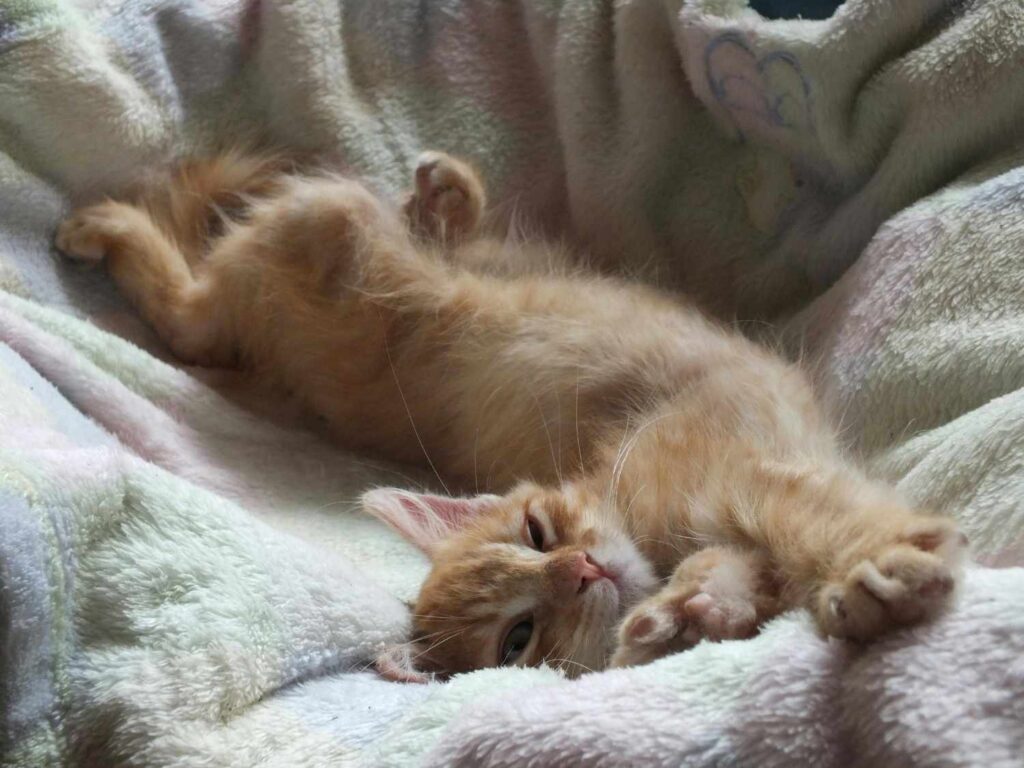
Cats may prefer the acrobatic position for several reasons:
- To stretch
- Contentment
- Comfort
When you spot your cat twisted into a seemingly impossible shape—back and front legs pointing in different directions, head at an odd angle—it’s likely showing off the acrobatic sleeping position.
This pose may look uncomfortable to you, but for cats, it’s often a sign of pure contentment and relaxation. Cats have remarkably flexible spines, allowing them to twist and stretch their bodies with ease. This flexibility enables them to find comfort in positions that appear awkward by human standards.
You might see this position after your cat has been exploring or playing. The cat’s body language here points to a carefree attitude. They are not trying to protect their belly or stay alert; instead, they rest in whatever shape feels most comfortable in the moment.
Every cat is unique, but if your cat sleeps like a contortionist, rest assured they are simply comfortable and at ease.
6. On Your Chest Cat Sleeping Position
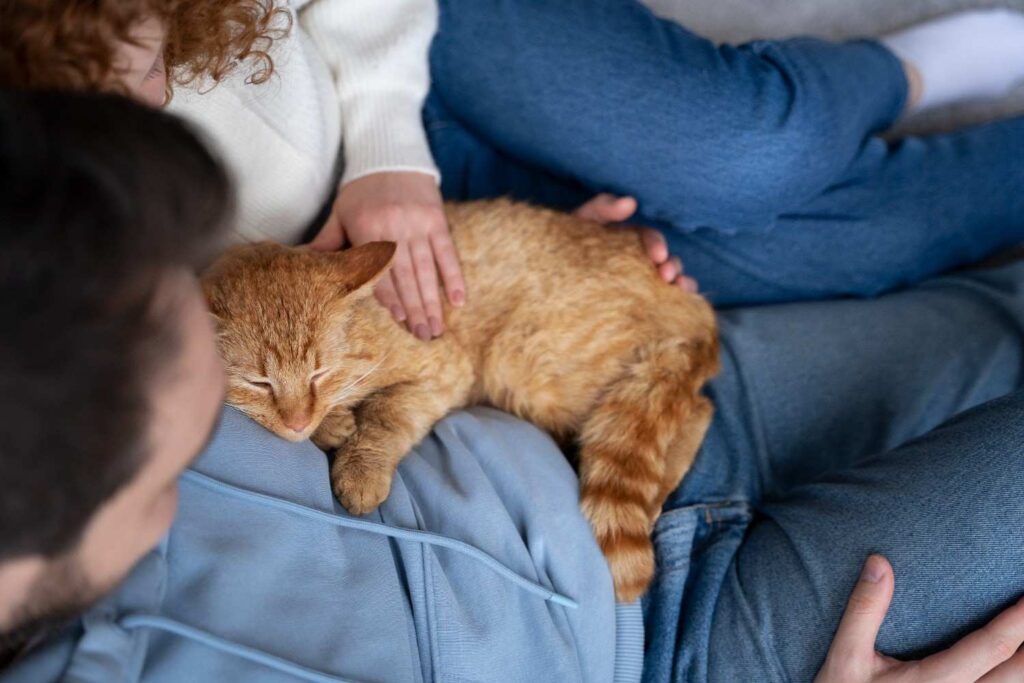
Cats may prefer sleeping on your chest position for several reasons:
- Warmth
- Bonding
- Comfort
When your cat chooses to sleep on your chest, it’s sending a clear message of trust and closeness. This position is often reserved for the people your cat feels most comfortable around. The steady rise and fall of your breathing and the sound of your heartbeat can have a calming effect.
A cat resting on your chest may be seeking warmth, but it’s also about security. Your scent and presence help your cat feel safe, making this spot a favorite during naps or at bedtime.
For many cat owners, waking up to a purring companion on their chest is a common occurrence. This is both a sign of affection and a request for a safe, quiet space.
If your cat consistently chooses your chest to sleep, consider it a compliment. They feel at ease and protected in your presence, making you their preferred resting place.
7. Sitting Upright Cat Sleeping Position (Posture)
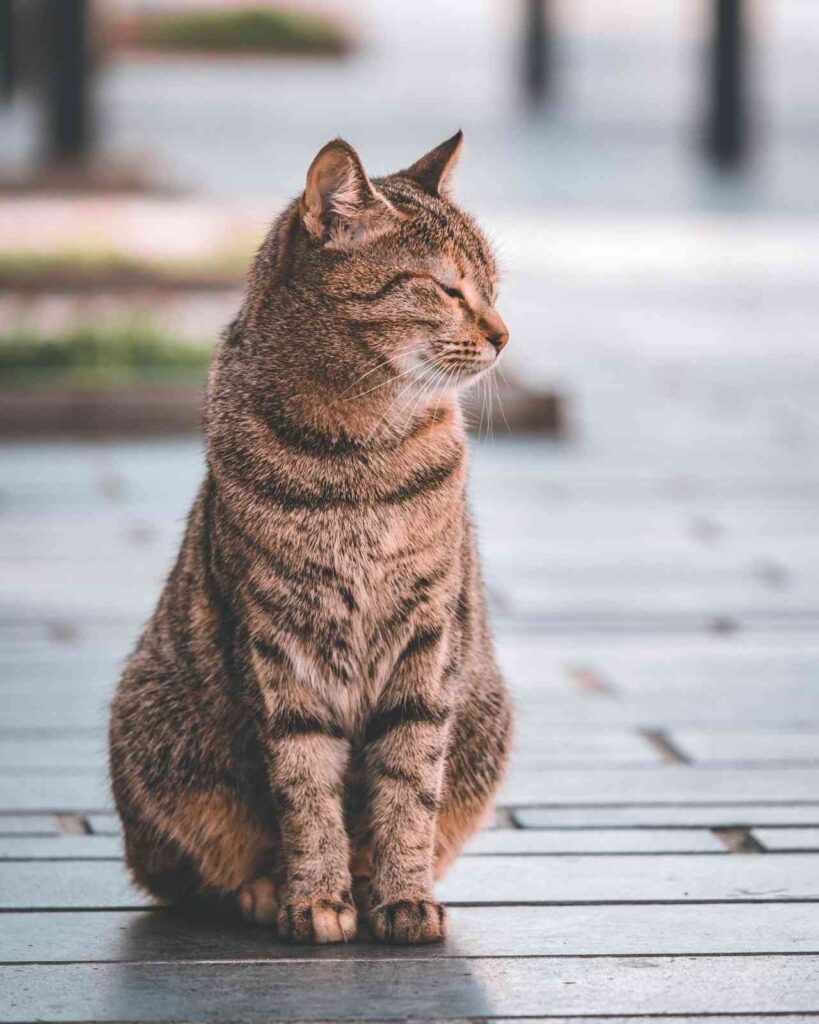
Cats may prefer sleeping sitting upright for several reasons:
- Safe and Relaxed
- Wants to be Groomed
- Comfort
When your cat settles into a sitting position for sleep, it’s a sign of deep trust in their environment. Your cat’s belly becomes more open, which signals they feel at ease and secure in your home. No animal exposes its most vulnerable area unless it’s confident about its safety.
You might notice this position when your cat dozes on the armrest of a sofa or perched in a sunny window. Sometimes, cats even nap like this after grooming, as sitting makes it easier for them to reach their stomach.
You may spot your cat in this sitting position when household activity is low, such as early mornings or quiet afternoons. This posture tells you your cat feels confident, prepared to relax but still able to react if needed, blending alertness with comfort.
8. Tucked In Cat Sleeping Position (Posture)
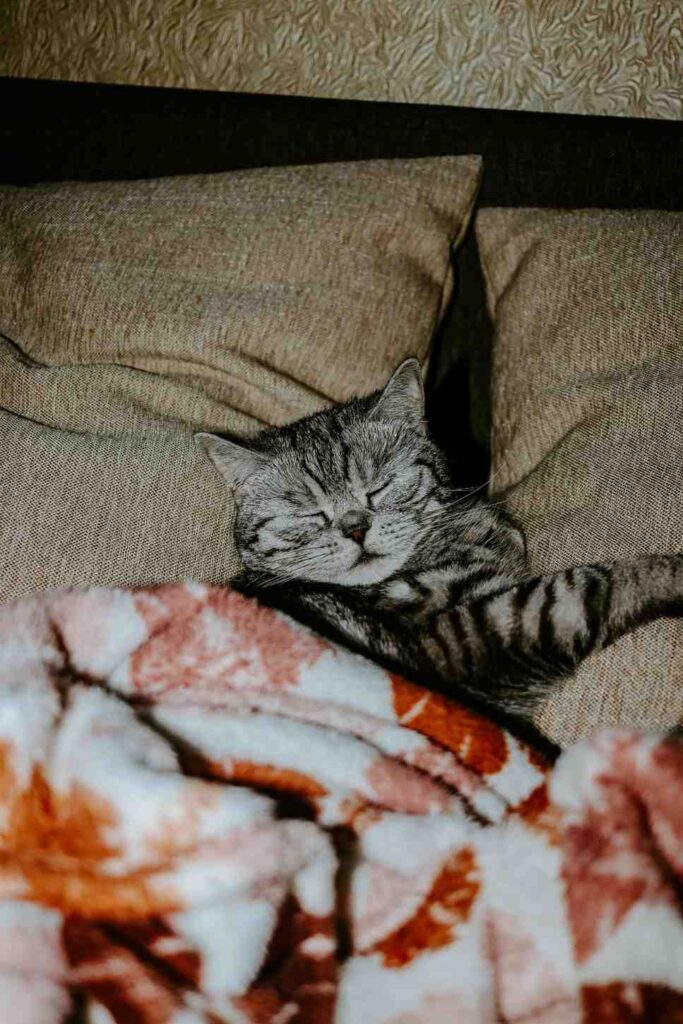
Cats may prefer sleeping in a tucked in position for several reasons:
- Temperature Regulation
- Noise Buffering
- Security
When you see your cat nestled beneath a blanket or tucked under the covers, it’s usually a sign they’re seeking warmth and safety. This position often means your cat wants to escape chilly environments or avoid disruptive household noises.
A cat sleeping “tucked in” communicates a sense of trust and comfort in its surroundings. By wrapping its body in fabric, your cat is expressing a desire for calmness and stability, often choosing spots that carry your scent. This familiarity helps your cat feel more secure.
The tail in a tucked-in position often lies close alongside the body, sometimes curling gently around the paws. This tail posture signals relaxation and contentment, suggesting your cat feels protected and at ease.
Common scenarios include your cat burrowing under your comforter during a thunderstorm or slipping into a pile of laundry on a bustling day. Your presence or scent can make these locations especially appealing.
9. On Your Head Cat Sleeping Position
Cats may prefer sleeping on your head for several reasons:
- Trust
- Bonding
- Accessibility
When your cat chooses to sleep on or near your head, it’s not just searching for any spot—it may be picking what it thinks is the safest and coziest place close to you. Your pillow is usually soft, and your head tends to stay fairly still at night, making it less likely to disturb your cat’s nap.
A cat sleeping on your head often signals trust and affection. By positioning itself near your face, your cat may be seeking warmth, comfort, and a strong sense of security from your presence.
You might notice your cat curling up on your pillow during cold nights or when it senses changes in your routine. This spot also allows your cat to stay connected, and gives it the option to gently wake you for attention, food, or play.
Emotionally, this position can mean your cat feels a deep bond with you. Your scent and steady breathing can offer reassurance, encouraging your cat to relax.
10. On Your Feet Cat Sleeping Position
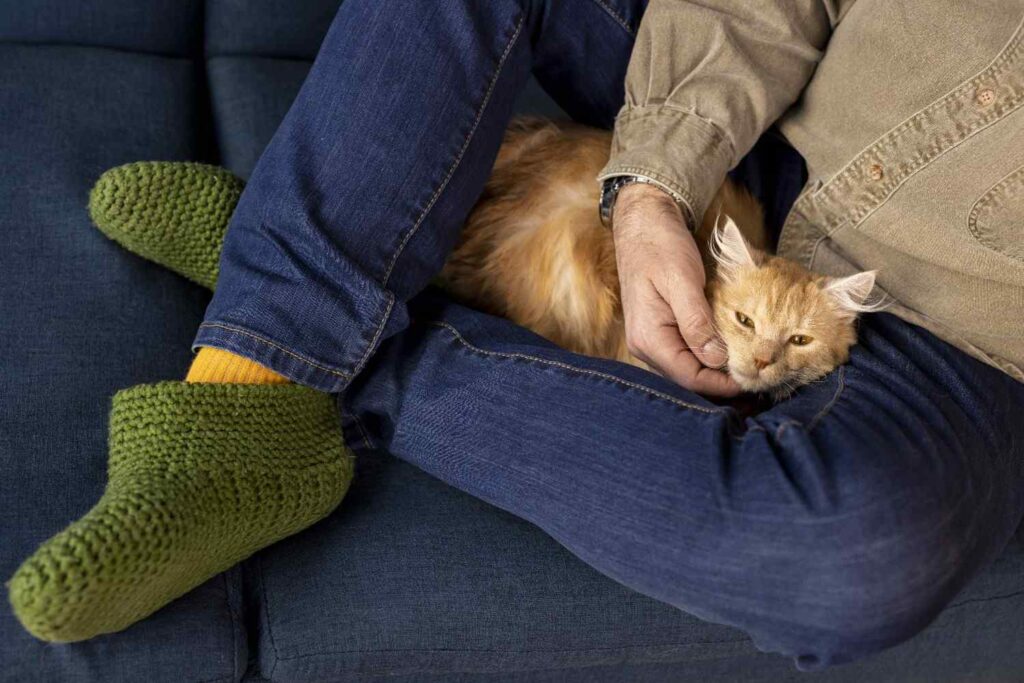
Cats may prefer sleeping on your feet for several reasons:
- Security
- Affection
- Boundaries
When your cat chooses to settle on or near your feet, it’s sending a message of trust and affection. Your presence provides warmth, and your cat uses this spot to enjoy cozy contact while maintaining a sense of safety and autonomy.
This position is common at the foot of your bed, on a couch, or even beside your chair. It allows them to be close to you, yet they have a quick escape route if they feel startled or need space.
On colder nights, it’s not unusual for them to curl up by your feet in bed, drawn by both your companionship and your body heat.
11. Sleeping with Other Cats
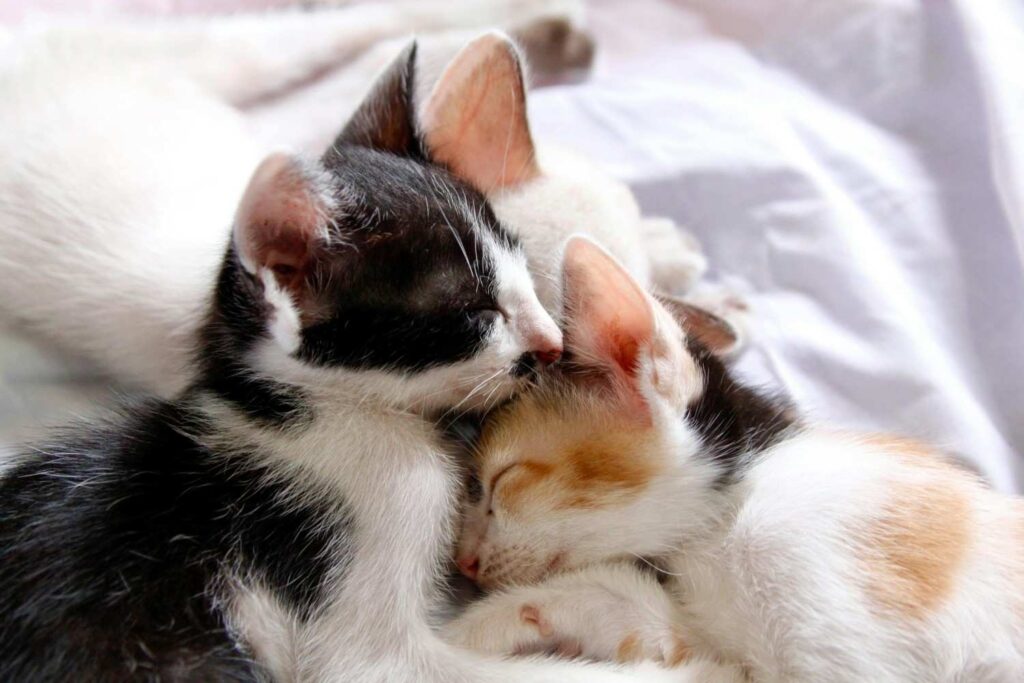
Cats may prefer sleeping with other cats for several reasons:
- Conserve body heat
- Comfort
- Bonding
Cats that choose to sleep side by side often display a strong sense of trust. Sharing sleep is one of the clearest signs of comfort in their social group.
You might notice your cats curled up together, sometimes with tails and bodies intertwined. When your cat has its tail draped over another cat while sleeping, it signals affection and security. This gentle touch shows that both cats feel safe and bonded.
Some cats will even gently knead one another as they settle down for a nap, which conveys both relaxation and contentment. You may also see your cats seeking out their companion when it’s time to rest, using each other as soft, warm pillows.
Common real-life scenarios include siblings from the same litter snuggling together on the sofa or two adopted cats forming a close friendship and sharing a favorite window perch. Bonded pairs often create their own little routines, dozing together in cozy corners or sunny spots.
12. Sleeping with Dogs
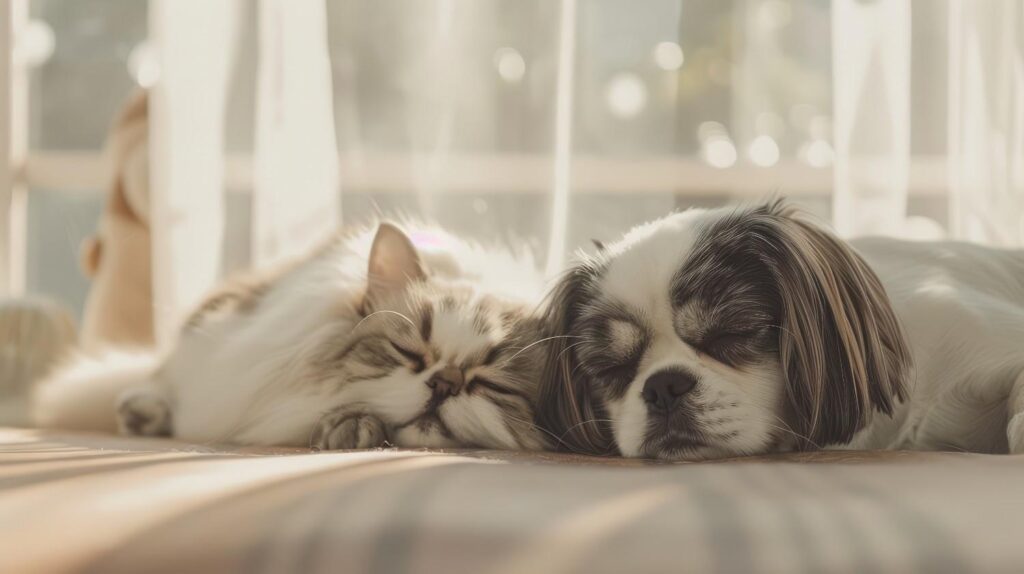
Cats may prefer sleeping with dogs for several reasons:
- Warmth
- Comfort
- Companionship
It’s not uncommon for a cat to be found curled up next to a dog, especially in homes where both pets have built mutual trust. This behavior tells you your cat feels secure—not only in their environment but also with their canine companion.
When sleeping with a dog, your cat may wrap their tail around themselves or gently across the dog. A tail tucked closely often signals comfort and a wish for warmth, while a tail that softly touches the dog may indicate affection and a strong bond.
This position sends a message of peace and acceptance. Your cat is showing that they view the dog as part of their social group. They find emotional comfort and physical warmth by sharing space like this.
For example, you might come home to see your cat easing onto the dog’s bed during a chilly day, both animals dozing peacefully together. This often starts after weeks or months of gentle introductions and shared positive experiences.
13. Eyes Open or Half-Open Cat Sleeping Position (Posture)
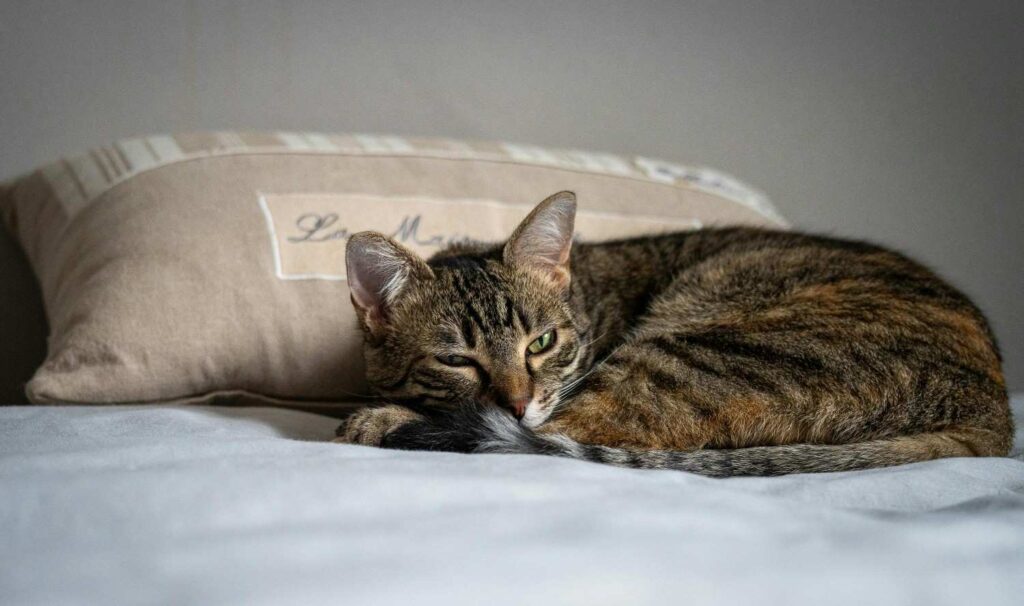
Cats may prefer sleeping with their eyes open or half open for several reasons:
- Vigilance
- Comfort
- External activities
Some cats rest with their eyes fully or partially open, or in some cases with weird cat eye movements. If you notice this, you might catch a glimpse of a hazy membrane over their eyes. This is a natural part of their anatomy that acts as a gentle shield while they sleep.
Cats often nap with one eye open or both eyes half-shut as a way to stay alert. This behavior comes from their instincts as creatures that need to watch for both prey and potential threats, even while they rest.
When your cat chooses to sleep this way, it is not necessarily a sign of worry or discomfort. More often, it reflects a state of light sleep. Your cat might be conserving energy but staying aware of movement in the environment, such as people walking by or another pet nearby.
While this posture is usually normal, keep an eye out for signs of discomfort or irritation. If your cat seems to do this constantly or appears unwell, a veterinary check with a full pet diagnostic service is recommended.
14. Paws Over Eyes Cat Sleeping Position (Posture)
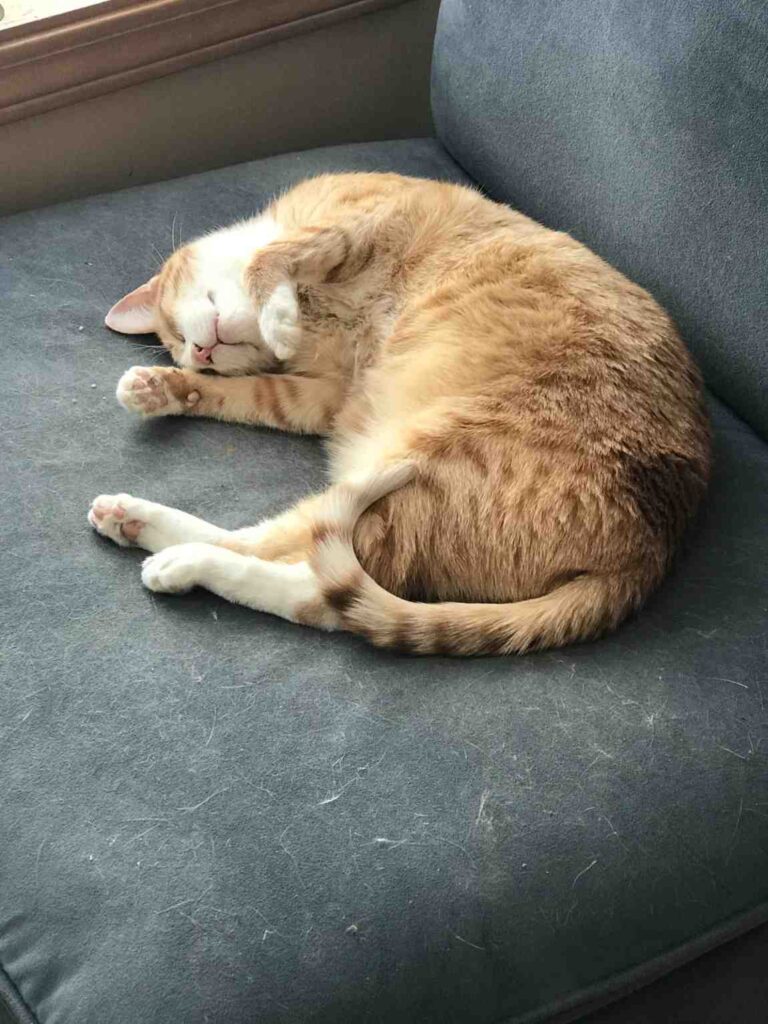
Cats may prefer sleeping with their paws over their eyes for several reasons:
- Protection from Light and Dust
- Comfort
- Sense of Security
Seeing your cat nap with its paws covering its eyes is both endearing and meaningful. When your cat covers its face like this, it’s more than just a charming pose—it serves practical purposes.
Some cats also do this in response to household activity. For example, if the lights are on late at night, or if people are moving around, your cat may block out the distractions in this way.
Next time you spot your cat napping in this position, you can be sure they’re finding both physical comfort and a sense of security in their environment.
15. In a Box Cat Sleeping Position
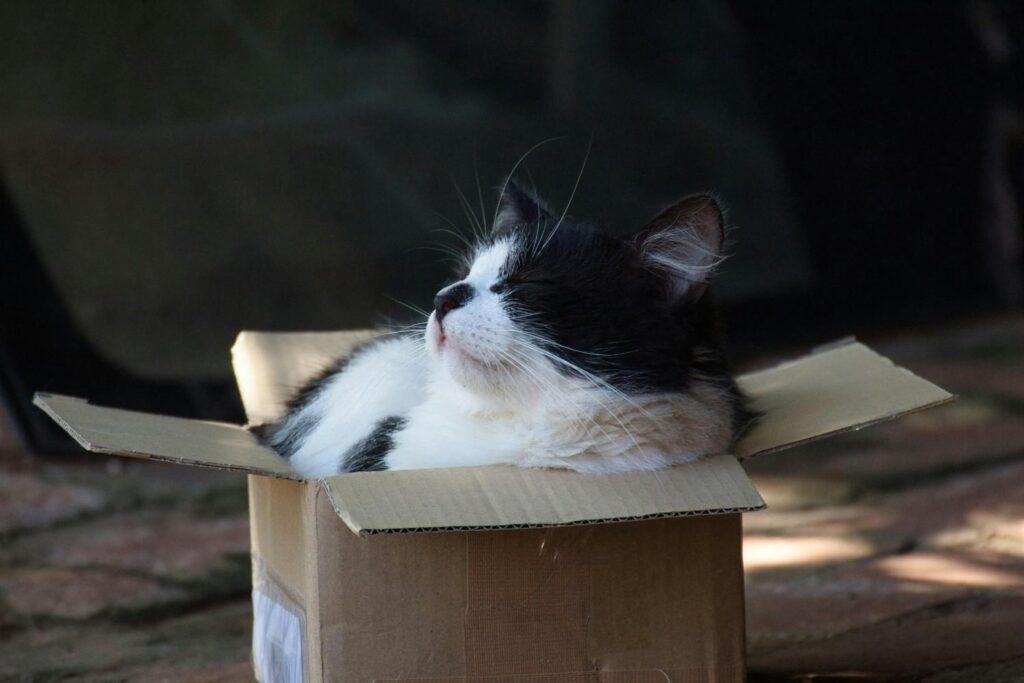
Cats may prefer sleeping in a box for several reasons:
- Security
- Coziness
- Relaxation
You might find your cat wedged tightly into a shoebox or lounging inside a shipping carton. This classic “in a box” pose is both amusing and meaningful.
Cats seek boxes because these spaces offer a sense of security. The high sides create a cozy, enclosed shelter where your cat can feel protected from all directions while still keeping an eye on what’s happening nearby.
Real-life examples include your cat slipping into a cardboard box during a family gathering, granting it a quiet retreat if things become overwhelming. Or, after returning home with groceries, your cat may hop into the empty bag or box as the new ideal napping spot.
This sleeping position is rooted in a cat’s natural instincts. Enclosed spaces help cats conserve body heat and provide an immediate hiding spot if they sense danger.
Other Interesting Facts About Cat Sleeping Positions
Here’s are some other interesting facts and frequently asked questions about cat sleeping patterns and cat sleeping positions.
1. What Are Some Cat Sleeping Positions When They Are In Pain?
When a cat is in pain, you may notice changes in their typical sleeping postures. A common sign is the hunched or crouched position, where your cat tucks its paws tightly underneath and makes itself compact, sometimes with a stiff body.
This pose may suggest discomfort or an attempt to protect sensitive areas.
2. What Does It Mean When A Cat Sleeps On Its Back Or With Its Belly Exposed?
When you see your cat stretched out on its back or lounging with its belly facing up, you’re witnessing a sign of deep comfort. Cats rarely leave their most sensitive areas unprotected unless they truly feel secure in their surroundings.
3. Should I Be Concerned If My Cat Is Hiding To Sleep More Than Usual?
If you notice your cat suddenly choosing hidden or sheltered places to sleep much more than before, it’s worth paying attention. While cats sometimes like cozy, tucked-away spots, a significant shift in this behavior can signal that something is wrong.
Common reasons include stress or anxiety. Seeking professional help from a veterinarian is the best practice here
.
Conclusion
Understanding your cat’s sleeping positions provides helpful insights into their emotions, comfort, and sense of security. You can often spot clues about their mood or health simply by observing how they rest.
Still, if you notice that your fur-friend is exhibiting weird behaviours, not just sleeping, it is best to seek professional help from veterinarians in the veterinary hospital over at Starlight.

Position: Committee Member, Chinese Veterinary Medical Association (Small Animal Ophthalmology)
Managing Director, STARLiGHT Veterinary Medical Centre
A graduate of the National Taiwan University College of Veterinary Medicine, Dr. Anya Chiu specializes in veterinary ophthalmology, animal welfare, and medical communication. She is deeply committed to advancing specialist veterinary education and international collaboration across Asia.





